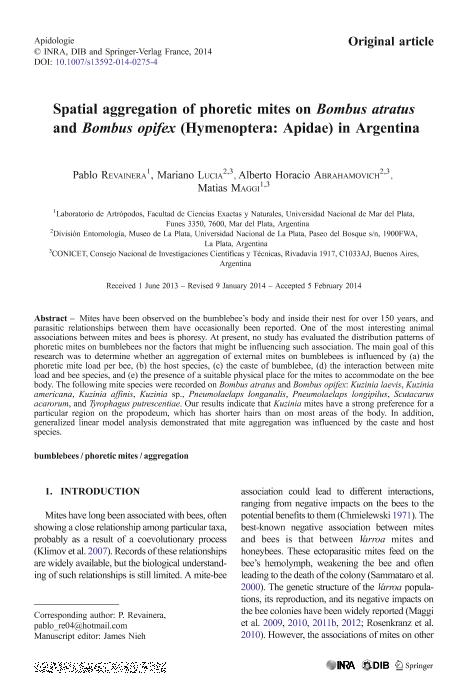Artículo
Spatial aggregation of phoretic mites on Bombus atratus and Bombus opifex (Hymenoptera: Apidae) in Argentina
Fecha de publicación:
02/2014
Editorial:
Springer
Revista:
Apidologie
ISSN:
0044-8435
Idioma:
Inglés
Tipo de recurso:
Artículo publicado
Clasificación temática:
Resumen
Mites have been observed on the bumblebee’s body and inside their nest for over 150 years, and parasitic relationships between them have occasionally been reported. One of the most interesting animal associations between mites and bees is phoresy. At present, no study has evaluated the distribution patterns of phoretic mites on bumblebees nor the factors that might be influencing such association. The main goal of this research was to determine whether an aggregation of external mites on bumblebees is influenced by (a) the phoretic mite load per bee, (b) the host species, (c) the caste of bumblebee, (d) the interaction between mite load and bee species, and (e) the presence of a suitable physical place for the mites to accommodate on the bee body. The following mite species were recorded on Bombus atratus and Bombus opifex: Kuzinia laevis, Kuzinia americana, Kuzinia affinis, Kuzinia sp., Pneumolaelaps longanalis, Pneumolaelaps longipilus, Scutacarus acarorum, and Tyrophagus putrescentiae. Our results indicate that Kuzinia mites have a strong preference for a particular region on the propodeum, which has shorter hairs than on most areas of the body. In addition, generalized linear model analysis demonstrated that mite aggregation was influenced by the caste and host species.
Palabras clave:
Bumblebees
,
Phoretic
,
Mites
,
Aggregation
Archivos asociados
Licencia
Identificadores
Colecciones
Articulos(CCT - LA PLATA)
Articulos de CTRO.CIENTIFICO TECNOL.CONICET - LA PLATA
Articulos de CTRO.CIENTIFICO TECNOL.CONICET - LA PLATA
Citación
Maggi, Matías Daniel; Abrahamovich, Alberto Horacio; Lucia, Mariano; Revainera, Pablo Damian; Spatial aggregation of phoretic mites on Bombus atratus and Bombus opifex (Hymenoptera: Apidae) in Argentina; Springer; Apidologie; 45; 5; 2-2014; 579-589
Compartir
Altmétricas




